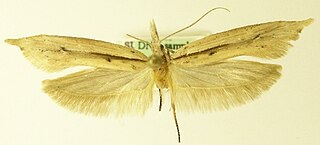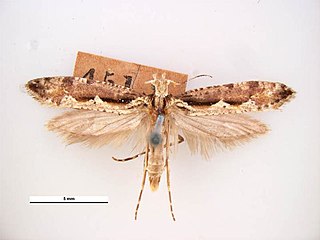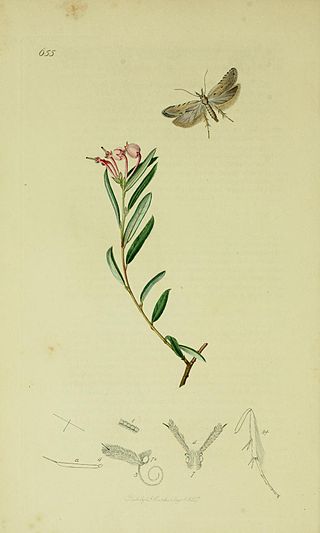Latrologa is a genus of moths in the family Gelechiidae. It contains the species Latrologa aoropis, which is found in Sri Lanka.

Udea olivalis is a species of moth of the family Crambidae. It was first described by Michael Denis and Ignaz Schiffermüller in 1775 and is found in Europe.

Elophila nymphaeata, the brown china mark, is a species of moth of the family Crambidae. It was described by Carl Linnaeus in his 1758 10th edition of Systema Naturae.

Eupselia satrapella is a species of moth of the family Depressariidae. It is found in Australia, where it has been recorded from Queensland, New South Wales and the Australian Capital Territory.

Ypsolopha mucronella is a moth of the family Ypsolophidae. It is found from Europe, through Siberia to Japan and in Asia Minor.

Trichoptilus ceramodes is a moth of the family Pterophoridae that is found in Australia, including New South Wales and South Australia.

Rhigognostis annulatella is a moth of the family Plutellidae. It is found in most of Europe.

Anarsia spartiella, the Wanstead grey, is a moth of the family Gelechiidae. It is found in most of Europe.

Phyllocnistis unipunctella is a moth of the family Gracillariidae. It is known from all of Europe.
Idiophantis chiridota is a moth of the family Gelechiidae. It was described by Edward Meyrick in 1914. It is found in Sri Lanka, Thailand, on the Sunda Islands and Fiji.
Stenoma nebrita is a moth of the family Depressariidae. It is found in Panama, Costa Rica and Guyana.
Stenoma trichocolpa is a moth of the family Depressariidae. It is found in French Guiana.
Cerconota trochistis is a moth of the family Depressariidae. It is found in French Guiana.
Deltoplastis figurata is a moth in the family Lecithoceridae. It was described by Edward Meyrick in 1910. It is found in Sri Lanka.
Idiocrates is a monotypic moth genus in the family Depressariidae. Its only species, Idiocrates balanitis, is found in Bolivia. Both the genus and species were first described by Edward Meyrick in 1909.
Hypercallia alexandra is a moth in the family Depressariidae. It was described by Edward Meyrick in 1909. It is found in Peru.
Antaeotricha plerotis is a species of moth in the family Depressariidae. It was described by Edward Meyrick in 1925. It is found in Peru.
Cerconota figularis is a moth in the family Depressariidae. It was described by Edward Meyrick in 1918. It is found in French Guiana and Colombia.
Chlamydastis smodicopa is a moth in the family Depressariidae. It was described by Edward Meyrick in 1915. It is found in Brazil and Peru.
Tiquadra syntripta is a moth of the family Tineidae. It is known from Brazil.








